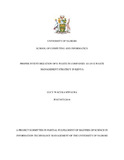| dc.description.abstract | E-waste is considered to be growing faster than any other waste stream in the globe. While many countries have invested in recycling of e-waste, most of it ends up in dumpsites. For this reason, it is important for a solution to be found upstream rather than downstream through reducing the amount of e-waste produced by consumers especially companies. Nonetheless, most companies in Kenya do not have data on the amount of e-waste they produce partly because of the complexity in inventorization of e-waste. Lack of data limits waste management action. Moreover, companies do not take action of reducing e-waste because they are unaware of the health hazard of e-wastes. The aim of the study was identifying the factors that need to be considered in developing an e-waste inventory system for use in companies. It also aimed at determining the costing methods for e-waste and finally coming up with an inventory system that could be used for monitoring the amount of e-waste produced by companies. Mixed method of research was used for the research. Data was collected through interviews, observation, literature review and questionnaires.
Data analysis indicated that having an e-waste management system raises awareness about the hazardous components in ICT equipment as well as their effect both to health and environment. As a result, organizations take e-waste management actions aimed at reducing the amount of e-waste they produce. Some of the e-waste reduction action identified includes buying high-end ICT equipment, reuse and refurbishing, purchasing ICT equipment that have more than one uses, developing policies specific to disposal of e-waste, collaborating with manufacturers and vendors, proper maintenance and purchasing environmental friendly ICT equipment. Some of the factors that need to be considered in developing an e-waste inventory system include weight, cost, risk factor and type of e-waste. The result indicated that the cost incurred by company as a | en_US |



